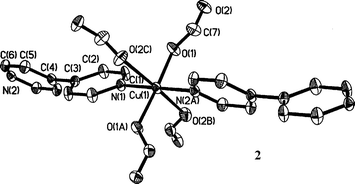The formate anion, HCO2−, has been used infrequently as a building block in molecular magnetic materials. We have synthesized and structurally and magnetically characterized two new Cu(HCO2)2L compounds, where L represents pyrazine (pyz) and 4,4′-bipyridine (bipy). The single crystal structure of Cu(HCO2)2(pyz), 1, has been established by both X-ray (295 K) and neutron diffraction (20 K). The compound consists of tetragonally-elongated CuN2O4 octahedra made up of four bridging formate anions and two neutral pyz ligands. The 3D polymeric network is comprised of 2D Cu(HCO2)2 layers that are fused together by the linear pyz spacers, which form Cu–pyz-Cu chains. Cu(HCO2)2(bipy), 2, is chiral and has a more complex framework than 1. The CuO4N2 octahedra align in two unique orientations relative to one another, owing to the 41 and 21 screw axes that lie along the a and b-axes. The octahedra are connected via four bridging HCO2− anions and two bridging bipy ligands, resulting in a unique 3D scaffold structure. The magnetic behavior of 1 and 2 indicates antiferro- and ferromagnetic interactions, respectively, and the exchange couplings in both 1 and 2 are well reproduced by a 1D spin Hamiltonian. Spin dimer analysis was carried out to evaluate the relative strengths of the various spin exchange paths. It is found that the interaction through HCO2− is comparatively weak, and the strong Cu2+ spin exchange interactions are mediated by the pyz and bipy ligands via the σ-pathway. A possible reason as to why 2 displays ferromagnetic coupling is proposed.

You have access to this article
 Please wait while we load your content...
Something went wrong. Try again?
Please wait while we load your content...
Something went wrong. Try again?


 Please wait while we load your content...
Please wait while we load your content...